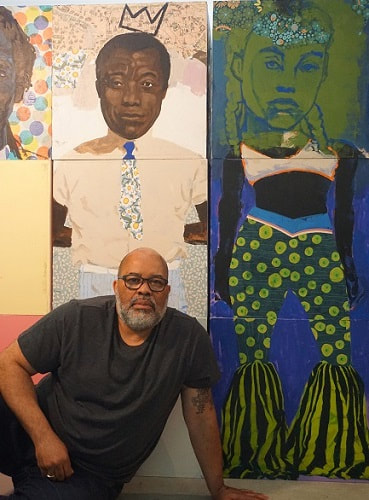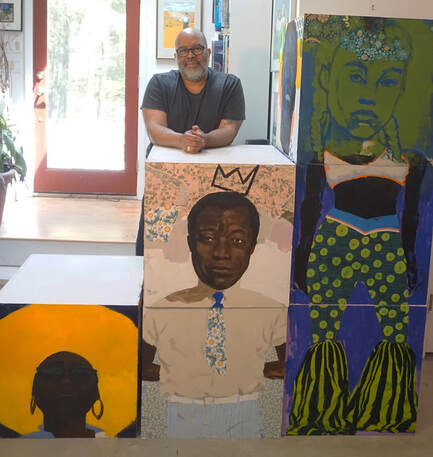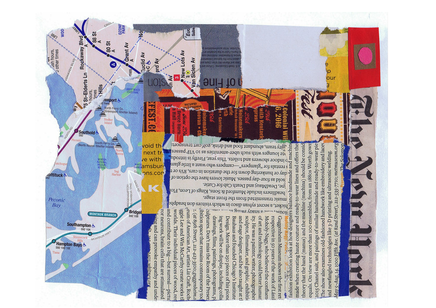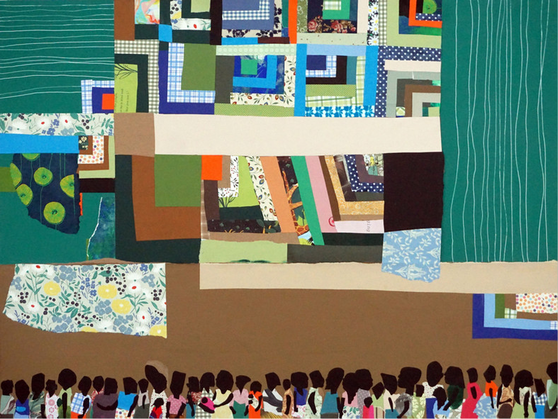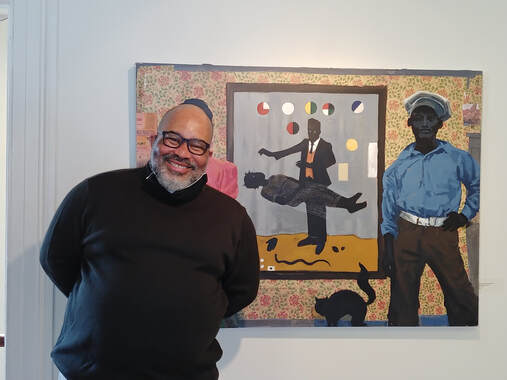JUNE 2021: Featured Artist
Mixed Media Artist:
Ransome
~~~
|
Ransome Posing with his Boxes
© Ransome |
Ransome's work is rooted in his African-American lineage, which is traced back to sharecroppers of the American South who migrated to Northern cities along the East Coast. Ransome was born in North Carolina and moved to a New Jersey suburb as a teenager. He received his MFA in Studio Arts from Lesley University.
His works combine acrylic paint with an array of found, made, and purchased papers. These works construct pictorial narratives that are personal, but whose symbols are universal and interplay with larger social, racial, ancestral, economic and political histories. Both his representational and abstract works incorporate a variety of symbols, patterns, and marks to create powerful images filled with the rhythmic properties of music that weave throughout his oeuvre. His mixed media aesthetics bring together diverse references from visual language that range from the classical canon to the current moment, from the bold action marks inspired by the Abstract Expressionists to gentle childlike scribbles. His influences are many, and his works recall the experimentation of hip hop deejays who sample large and small beats from an array of music genres, the resourcefulness of Quilters of Gee's Bend, or the improvisational playing of Jazz music. It is the thoughtful placement of these parts that creates the unique visual voice of Ransome, who uses what is at hand, assembling, collaging and creating. Today, Ransome’s work is part of both private and public collections, including the Petrucci Family Foundation Collection of African-American Art and the esteemed Beth Rudin DeWoody Collection at The Bunker, her contemporary art space in West Palm Beach, Florida. Two of his works -- Love and Who Should Own Black Art?— have been selected by the Katonah Museum of Art for “Cladogram: 2nd KMA International Juried Biennial,” which will open this July. |
Myrna Haskell first met Ransome at his solo show titled "The View from Here" at the Barrett Art Center in October 2020. Since then, Ransome has completed his MFA and has a new series of work which he describes below.
|
Ransome with a Sampling of his "Millennium" Boxes
© Ransome |
What was the inspiration behind your portrait box series, Millennium?
Like most ideas, the boxes really came from several sources. I grew up with my grandmother who would say it was a good omen for things to appear three times from three different sources. And two of my favorite artists, Jean-Michel Basquiat and Robert Rauschenberg, both went beyond the traditional canvas and painted on three dimensional objects. Robert Rauschenberg advanced this concept of dimensionality with his Combines works - his hybrid works of paintings, collage and assemblage that used objects from everyday life. And if you know anything about Basquiat, you know that he painted on all types of objects as well. I always admired Jean-Michel Basquiat’s boxes, which recalled Andy Warhol’s Brillo boxes. I especially like the way these boxes looked when stacked; they gave the art a different feeling, a more casual or artless feeling - like merchandise stacked on a showroom counter. The idea of life-size boxes came when my wife and I were traveling. I noticed a display in the Aloft hotel lobby of a stack of boxes with the company’s name. This goes to show you that art and ideas are often all around us. |
But mostly the idea came from an assignment in my undergrad Media Arts class at Pratt Institute. Our first semester, sophomore assignment was to paint the same portrait of ourselves six different times using six different mediums. Then we would cut the portraits up and glue them to cardboard boxes. So really this is a larger version of this assignment which I really adored because you could rotate and exchange different parts of the face, done in different mediums, like a Rubik’s cube.
|
Boxes in Progress
© Ransome |
"Modern Black people deal more with the institutional racism, rather than the individualized racism that their grandparents dealt with. The freedoms that Black youth have were unimaginable to their predecessors, and that’s what I wanted to paint - the contrast and advancements between the people who dream and the people who often live out those dreams. They have the freedom to express themselves with unconventional hair, clothes and jewelry in ways that may have matched the spirit of their elders but that those same elders never had the freedom or agency to express." ~ Ransome (Partial Artist Statement) |
You've planned portraits that exude differences in class, culture and heritage. What do you want the viewer to learn from this?
The idea continues to grow and change. At first, I was just going to paint life size portraits of Afro Punks. I feel a connection with these young people and their eccentric clothing because I’m a big Parliament-Funkadelic fan, and the original band members were the first Afro Punks that I’m aware of. Then, I realized that I wanted to go beyond just painting portraits of punky folks, and I started thinking about code switching and how some Black people don’t feel connected to the stereotypical African American styles and cultural fads - Black skaters and Black hippies. Then, I thought about the current Black Lives Matter movement and its intersections with transgender visibility, and this became a real focal point.
Recently, I began naming the people and really flushing out their personalities. James Baldwin had to be added, mainly because much of his writing has come back into what Black people in this country are still dealing with. Maybe I am saying that there is more to us than how we appear on the surface – that we all have potential for greatness and genius. We share many of the same concerns - you can exchange parts or your clothes, but you are still a person, and each person has basic needs.
Will these various blocks be interactive so that a viewer can manipulate them into a different composition?
I do not think the viewers should reformat the boxes because that would be like rearranging a wall of paintings in the Museum of Modern Art. But curators and displays will change from exhibit to exhibit.
The idea continues to grow and change. At first, I was just going to paint life size portraits of Afro Punks. I feel a connection with these young people and their eccentric clothing because I’m a big Parliament-Funkadelic fan, and the original band members were the first Afro Punks that I’m aware of. Then, I realized that I wanted to go beyond just painting portraits of punky folks, and I started thinking about code switching and how some Black people don’t feel connected to the stereotypical African American styles and cultural fads - Black skaters and Black hippies. Then, I thought about the current Black Lives Matter movement and its intersections with transgender visibility, and this became a real focal point.
Recently, I began naming the people and really flushing out their personalities. James Baldwin had to be added, mainly because much of his writing has come back into what Black people in this country are still dealing with. Maybe I am saying that there is more to us than how we appear on the surface – that we all have potential for greatness and genius. We share many of the same concerns - you can exchange parts or your clothes, but you are still a person, and each person has basic needs.
Will these various blocks be interactive so that a viewer can manipulate them into a different composition?
I do not think the viewers should reformat the boxes because that would be like rearranging a wall of paintings in the Museum of Modern Art. But curators and displays will change from exhibit to exhibit.
|
I am impressed with your collage work. Any new directions we can expect in this area?
I want to go larger with the collages. Many of them were done in my 9 x 12-inch sketchbook, and I always leave a very generous white space around all sides, so the actual collages are 6 X 8 to 8 X 9 inches. Soon I will start working on several 24 x 30” collages before I move to 40 x 60” and larger sizes. I will still work with the same elements of found, purchased and painted papers. |
The A Train
Collage © Ransome |
|
Quilt Folks
Acrylic & Paper Collage: 30 X 40 inches © Ransome |
Your use of patterns has been inspired by the work of Gee's Bend quilters. These quilters were not dictated by traditional art, instead by community traditions and culture. Do you think you'll continue to use quilt patterns in your work? If so, why?
Yes, quilts will always be a part of my practice. For me, the use of quilt designs - and having them associated with the Women of Gee’s Bend - adds a depth and history to my art making. More than anything I feel that patterns and colors are a strong way to communicate to my audience. If I place a pattern down of a certain color, and you see it and say, “That reminds me of my grandmother,” well, that’s what I’m after. There are often popular patterns and colors from the 70’s, 80’s, 90’s - every decade. I try to tap into that sensibility. "You can see that my narratives are personal, yet the symbols I use are universal and interplay with larger social, racial, ancestral, economic and political histories that inform our nation to this day. The history of my family is the history of Black Americans, which, in turn, is the history of all North America." ~ Ransome (Partial Artist Statement) |
|
Ransome posing with his piece "Who Should Own Black Art?" during the opening of his solo exhibition The View from Here
at Barrett Art Center in Poughkeepsie, NY Myrna Haskell interviewed Ransome about his solo show
"The View from Here" in October 2020 |
Follow Ransome on:
UPCOMING EXHIBITIONS:
Mass MoCA "An Unpredictable Time & Place" Lesley Art + Design MFA Thesis Exhibition Opening July 2 - 6:00 p.m. Katonah Museum of Art "Cladogram: 2nd KMA International Juried Biennial" Two Pieces selected: "Love" & "Who Should Own Black Art?" Opening: Sunday, July 11 Exhibition through September 19, 2021 Samuel Dorsky Museum of Art "Who Really Cares?: Hudson Valley Artists 2021" July 7 – November 14, 2021 Alice and Horace Chandler and North Galleries Band of Vices "MASTERPIECE II: Globalization, Pandemics & Racial Reckoning: Where Do We Go From Here?" July 19 through August 14, 2021 |

